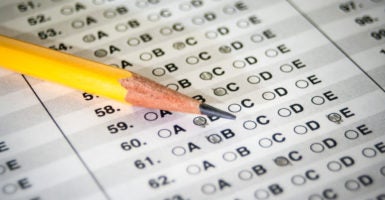“It’s misleading. How do you measure an ‘adversity score’ anyway?”
Martin Smith, a professor at Rowan University and an alumnus from the University of Pennsylvania, shared his thoughts over the College Board’s recent unveiling of an “overall disadvantage level”—in shorthand, an “adversity score”—to supplement students’ SAT scores.
“You can’t manufacture equal outcomes when everyone isn’t given the same resources,” he said.
Smith hails from a small town in rural Tennessee, a place that knows disadvantage all too well, yet he was less than optimistic about the new score supplement that’s meant to help less-privileged students stand out compared with their better-off peers during the college admissions process.
On a scale of 1 and 100, a student’s adversity score will indicate several factors that colleges should take into account when considering a candidate for admission.
The purpose of the adversity score is to be an indicator to college admissions officers of the socioeconomic difficulties that a particular candidate might have faced during his or her formative school years.
Any setbacks that might result in a seemingly low score might actually accrue to a student’s advantage when realizing the student’s comparative disadvantage relative to other national and international candidates.
An op-ed essay in the Atlantic magazine argues that despite the problems the new adversity score faces, it is a “long-overdue” innovation and a step in the right direction.
Then there are those who complain that the score does not go far enough. Another op-ed, this one in Time magazine, argues that in gathering 31 data points that focus primarily on a student’s socioeconomic background, it is dancing around the more important element; namely, race.
The College Board avoids race-based criteria. It describes its data as aggregate and census-based, comparing a particular school’s neighborhood with the school itself on information regarding median family income, poverty rate, the percentage of adults with high school diplomas, the percentage of adults with nonprofessional jobs, the environment’s “college-going behavior,” or the environment’s probability for being a victim of a crime, to name a few.
Even after these measuring tools were explained to Smith, his opinion about the adversity score had not changed.
“No, because it’s not fixing the problems in that neighborhood. It’s allowing the elites to cherry-pick those [students] they may find useful while allowing the rest of the neighborhood to fester and wallow,” he said.
His skepticism points to a greater problem with the adversity score: It implicitly makes hardship or disadvantage, and the liberation from it, about going to college.
With respect to the College Board’s criteria, adversity is just a number that can get you into college. Adversity is considered a variable that serves as a gateway into college, but it does nothing to indicate to that student what it means to attend university coming from a disadvantaged background.
The U.S. Department of Education mentions how inadequate academic preparation is often a key factor in lack of college success for underrepresented students. “Members of low-income families are much less prepared for college than their higher-income counterparts,” it states.
The problem can be extended to first-generation and minority students, who have a similar difficulty graduating on time.
By making adversity an advantageous element, it’s then difficult to envision a motivation for underprivileged school districts and municipalities to actually make an effort to change any of the problems in their area that might hinder preparing their students for success in college, not just getting them through the door.
For universities, an adversity score becomes another way to prioritize diversity as the most important goal for admissions staff. It is in the interest of universities to strive for diversity, since a greater number of applicants means more profit, or, at the very least, more publicity for the institution.
Yet, their efforts to help low-income students stay in college are not as impressive.
College admissions are meant to select students that would thrive and provide value to the school. When a student applies to college, he is signaling his abilities.
There is no denying that often, more affluent students are able to create an upward bias on the criteria for university admissions by taking advantage of test preparation, college consultants, and other extraneous resources that are not available to low-income students. But while colleges might begin to accept more low-income and minority students to level the playing field, this act will not ensure their success.
Of course, test scores are not exclusively indicative of a student’s ability to thrive and provide value, but they do indicate at some level how a student will fare, based on the resources that are provided to him or her.
The focus needs to be on providing those resources to low-income students before they indebt themselves, psychologically and fiscally, to a higher education institution.
It would appear, then, that the objective should not be getting low-income students into elite colleges, but giving students in underprivileged districts the necessary tools and primary education with which to thrive in any college.































